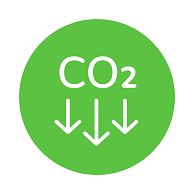- Home
- Leveraging Gasification to Lower a Project's Carbon Intensity Score
Leveraging Gasification to Lower a Project's Carbon Intensity Score
December 06, 2022
Carbon Capture in Syngas Based Projects
Recent legislation, such as the Low Carbon Fuel Standard (LCFS) and the Inflation Reduction Act (IRA) passed in the US, provide financial incentives for projects generating power, transportation fuels, or other forms of energy to reduce their overall carbon emissions. The carbon intensity (CI) score is the accepted measure of the effectiveness of carbon emission reductions. In simple terms, the CI score of a project is the amount of carbon dioxide equivalent emissions per unit of energy. Because of the aforementioned financial incentives, many projects are under development in the US today to produce green energy. These include the production of renewable diesel and jet fuel from soybean oil, corn oil and animal tallow, and the generation of various energy products from non-fossil fuels such as woody biomass or municipal solid waste. For this discussion, we will focus on the latter of these.
Many process technologies exist to convert fossil fuels into various forms of energy. Gasification is a process that has been in practice for decades. Gasification generates a synthetic gas, also known as syngas, from any hydrocarbon-based feed stream. It is primarily comprised of a mixture of carbon monoxide and hydrogen in varying ratios. This syngas can be converted to various forms of energy – hydrogen, methanol, gasoline, diesel, aviation fuel, and ammonia. This has typically been applied in parts of the world that are coal rich and do not have ready access to natural gas or liquid crude oil. These projects have provided affordable energy products for decades but are burdened with substantial amounts of carbon dioxide (CO2) emissions.
CLEAN FOR GREEN

These same gasification-based technologies can be modified to accept renewable feeds in place of the more traditional fossil fuels. These renewable feeds include woody biomass, agricultural waste, and municipal solid waste (MSW). If left to degrade naturally in the forests or landfills, these feeds will generate a significant amount of methane. Like carbon dioxide, methane is a greenhouse gas. However, the greenhouse gas impacts of methane emissions are estimated to be ≈80 times greater than CO2 over a 20-year period and ≈30 times that of CO2 over a 100-year period (larger impacts are estimated in shorter time frames). By converting these feeds to fuels, instead of allowing them to degrade into methane, we lower the carbon intensity of fuels. “Renewable fuels,” as they are called when created with these feeds, have a much lower CI score than their fossil fuel counterparts.
In the process of gasifying (creating syngas from) woody biomass or MSW, some amount of CO2 is usually produced. This CO2 can be removed from the syngas and vented to the atmosphere, or it can be captured. When the CO2 is captured, the carbon intensity score of the project can be significantly improved.
Carbon capture can also be used to improve the carbon intensity of the conversion of natural gas to hydrogen through steam methane reforming. Today, over 95% of the world’s hydrogen is produced using steam methane reforming without any carbon capture. In these projects, essentially 100% of the carbon in the natural gas is converted to CO2 and vented to the atmosphere. With the implementation of carbon capture on these technologies, ≈ 60-65% of the carbon in the natural gas can be captured.
The technologies used to capture carbon in the form of CO2 from syngas are very mature and have been used for more than 50 years. There are hundreds of gasifiers operating globally that use these technologies to “clean up” the produced gas by removing CO2 [and hydrogen sulfide (H2S)] to generate a syngas that meets the desired product requirements. In many cases prior to 2020, all CO2 that was captured in these projects was released into the atmosphere, as there was no financial incentive to sequester it. However, in today’s market, there are several economic, environmental, social and governance (ESG) incentives for sequestering the CO2. The decision made on incentives can either result in an additional income stream or the generation of carbon credits that can be sold or traded.
While these additional factors are also important to consider when the CO2 will be sequestered, the same basic technologies can be employed for the capture step. In addition, some newer technologies are being developed and/or optimized to improve the economics of the capture/sequestration combination.
CARBON CAPTURE TECHNOLOGIES

Chemical solvent technologies have been used for decades to remove acid gases, including CO2 and H2S, in both syngas applications and refining applications. With a chemical solvent, the syngas is contacted with the solvent and there is a chemical reaction between the solvent and the acid gas components in the syngas. This “traps” these species in the solvent and results in “clean” syngas. The rich solvent, containing the trapped acid gases, is then regenerated by heating and decreasing the pressure to reverse the reaction and release the acid gases back into a gaseous stream. This process is very mature and well understood and has many applications in technology used in projects involving syngas worldwide. Chemical solvents include various forms of nitrogen-based compounds known as amines. The most common amine applied for the removal of CO2 from syngas is methyl diethanolamine, or MDEA. Producers of MDEA offer various versions of the solvent that can contain promoters or other additives to improve the performance of the MDEA for specific applications. MDEA can achieve deep removal of CO2 but is less effective at selective removal of CO2. This can be a very important consideration if there are sulfur species present (H2S, Carbonyl Sulfide [COS], etc.) in the syngas.

Is there an alternative?
Physical solvents can also be used to remove CO2 from syngas. These solvents rely on the physical absorption of the CO2 into the solvent. These technologies are also widely used in the syngas and gasification industry. Because these solvents rely on physical absorption, they are more effective at elevated pressures. Similar to the chemical solvents, the syngas is contacted with physical solvent and the CO2 is absorbed into the solvent resulting in a “clean” syngas stream. The solvent can also be regenerated for reuse. Much of the acid gas can be released simply by flashing (reducing the pressure) of the solvent. This allows a portion of the CO2 to be released at elevated pressures which can reduce the CO2 compression costs downstream. For full regeneration, the solvent pressure must be fully reduced, and some steam stripping applied. In general, the amount of steam/energy required for regeneration is less for physical solvents than it is for chemical solvents. Due to the differing absorption affinities for different components, physical solvent systems can be configured to remove CO2 and H2S selectively, resulting in a fundamentally H2S-free CO2 stream. Many physical solvents are well-known licensed technologies such as Selexol™, Rectisol®, Purisol, and the Fluor Solvent.
Cryogenic technologies are also mature and commercially proven technologies used to capture CO2. However, cryogenic technologies are capital as well as operating cost intensive compared to solvent-based technologies. These cryogenic processes have been deployed on a commercial scale, are proven, mature and dependable. In general, starting with a higher fraction of CO2 in the gas mixture is a favorable condition for cryogenic separation. The gas mixture is dried, compressed, cooled to exceptionally low temperatures, and fractionated to separate out CO2 using the difference in boiling points of the components. With projects that intend to use onsite CO2 injection into a geologic formation, these technologies may be more economic, depending upon other project requirements and criteria.
The following innovative technologies are in varying stages of development. These technologies require further supporting and pilot plant operating data for commercialization, but may be of interest in future projects as the technologies mature:
- - Hydrophobic Alkyl Ester Solvent technology
- - Carbon Clean’s Amine Promoted Buffer Salts (APBS)
- - Amino Sulfonic acid technologies
- - Solid sorbent technologies: metal organic framework, Zeolite 13X activated carbon and alkali metal carbonate or hydrated solid sorbent processes

What should be considered when selecting a technology?
Carbon capture technology selection criteria can include multiple gasification
technologies, multiple feedstocks, multiple end-uses for the syngas, and multiple sequestration or use options for the captured CO2. There is not a simple answer as to which of the various carbon capture technologies will be preferred for a given project. This important technology decision is something that needs to be studied carefully in the early stages of project development.
Some key criteria that should be considered during this analysis include:
- - Feedstock/syngas sulfur content: The concentration of sulfur in the syngas (lb./lb.), the total amount of sulfur in the syngas (lb./day), and the sulfur species that might be present in the syngas (H2S, COS, Mercaptans, other) can impact the CO2 capture technology selection. For example, larger amounts of sulfur may drive an economic preference for physical solvents over chemical solvents.
- - Presence of heavy hydrocarbons (tars & oils) in the syngas: The gasification of biomass and MSW can result in some level of heavy hydrocarbons in the syngas. Each unique gasification technology will have its own tar reduction technology/strategy that may result in varying amounts of heavier hydrocarbons remaining in the syngas. Physical solvents can absorb heavy hydrocarbons from the syngas that can lead to operational problems.
- - Final product requirements: Syngas can be converted into numerous end products including hydrogen, methanol, ammonia, gasoline, aviation fuel, and natural gas. To achieve the conversion to these final products, additional processing of the syngas is required to meet the key specifications for each of the downstream processing steps. Some of these specifications include CO2 content, sulfur content, specific hydrogen-to-carbon monoxide ratios, and heavy hydrocarbon limits. The various steps required to achieve the desired syngas concentration at the inlet of the downstream processing unit (often referred to as syngas conditioning) may drive the selection of the CO2 capture technology.
- - Operating pressure: Physical solvents are more effective as the pressure of the syngas increases. When the pressure drops below about 400-500 psig in syngas applications, chemical solvents may provide a more economical solution.
- - Abundance of low-level steam: Depending upon the other units in the facility, the plant may have either a shortage or an abundance of low-level steam. Chemical solvents require larger amounts of steam. If there is not adequate steam available without additional consumption of fuel, moving to a physical solvent that uses less steam may be worthwhile.
- - Green power availability: Different technologies require differing amounts of electricity. If green power is not available, additional power consumption must be generated with fossil fuels which can have a significant impact on the carbon intensity of a project.
- - CO2 disposition: Many current projects plan to sell CO2 into existing pipeline networks, while other projects are investigating on-site CO2 injection wells. The disposition of the CO2 will drive requirements (pressure and purity) that may influence the optimum CO2 capture technology.
TAKING THE FIRST STEP

KP Engineering has significant recent experience with multiple green energy projects. These projects include various gasification technologies, multiple syngas end-products, and projects with and without carbon capture. We have a strong team of engineers with experience in syngas generation, syngas conditioning and CO2 capture (in open-art applications as well as licensed design basis). These experts are highly experienced and qualified to provide engineering services in these areas from the early conceptual stage and investment studies to the detailed engineering and final EPC (engineering, procurement, and construction) stage of projects.
Need to lower your project's carbon intensity score to meet financial or regulatory incentives? Leverage KPE's experience in commercializing leading technologies for carbon reduction.